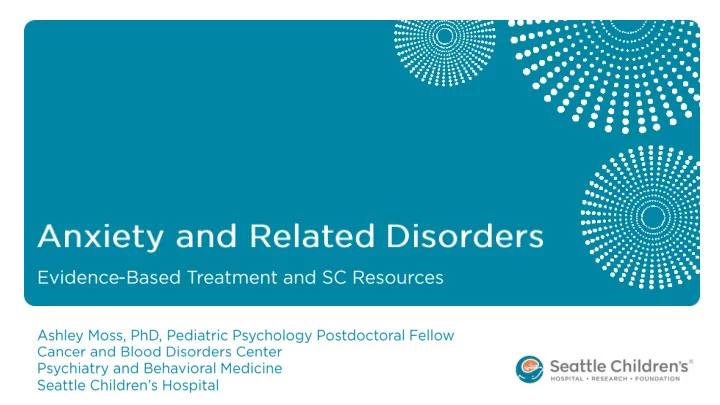

• Anxiety is normal, adaptive, and protective • Anxiety varies in intensity from person to person • High levels of anxiety are problematic • Lowering the volume , not changing the station Developmental Stage Common Fears/Worries Infancy Loud noises, loss of support, heights, strangers, separation (in the present) Preschool Animals, the dark, storms, imaginary creatures, anticipatory anxiety School-Aged Specific realistic fears, school achievement, natural events Older Children/Adolescents Fear of fear (ability to think abstractly about fears), school performance, social competence, health
• • • • • • • •
• – – – • – – • – –
Separation Anxiety Disorder Selective Mutism Specific Phobia Social Anxiety Disorder Panic Disorder Agoraphobia Generalized Anxiety Disorder • • • •
•
• Chronic excessive worry in a number of areas (e.g., school, internal standards with social interactions, family, health/safety, world events, natural disasters) & at least 1 somatic complaint
• Discomfort or fear in one or more social settings that involves a concern about being judged or evaluated
• Presence of obsessions and/or compulsions • Obsessions: Recurrent and persistent thoughts, impulses, or images that are intrusive and cause marked anxiety or distress; but are not excessive worries about real-life problems • Compulsions: Repetitive behaviors or mental acts that the person feels driven to perform in response to an obsession in order to reduce stress or avoid feared situation
• Anxiety is often observed among children who have experienced maltreatment and trauma (but not all youth who are anxious experienced trauma) – Majority of children manifest resilience in the aftermath of trauma • Traumatic stress occurs when youth are exposed to traumatic events/situations which overwhelms their ability to cope • Trauma Symptoms: Hyperarousal/Reactivity (e.g., inattention, anxiety, disrupted sleep); Re-experiencing (e.g., intrusive thoughts, flashbacks); Avoidance (e.g., dissociation); Negative Alterations in Cognition/Mood (e.g., irritability, distress, anger, anxiety • Impact on social-emotional functioning and lead to increased vulnerability for other psychological disorders (e.g., anxiety, depression)
Likely caused by a combination of factors • Genetic Anxiety • Temperament Long Term : More Increased arousal, physical symptoms, emotionality, • behavioral inhibition worry, loss of scanning for danger, confidence in coping physical symptoms • Parenting ability, increased intensify, attention safety behaviors • Reinforcement & Modeling narrows and shifts to self • Cognitive Factors • Avoidance Short Escape or • Environmental/Life stressors Term : Avoidance Relief
• American Academy of Child & Adolescent Psychiatry (2007) recommends a two-pronged approach for treating anxiety: • Cognitive Behavioral Therapy (CBT) • Most studied and empirically supported • CBT is the first line of treatment for youth with mild-moderate anxiety • Medication • SSRIs (e.g., Zoloft/sertraline; Lexapro/escitalopram) • CBT & Medication • Acute symptom reduction in moderate – severe cases • Comorbid disorder • Partial response to psychotherapy
• Exposure is the “active” or vital ingredient • More exposure practice = better outcomes • Anxiety management strategies (e.g., emotion identification, relaxation skills, cognitive strategies) • Little direct evidence of added value, may not be necessary for improvement • Not sufficient as a stand alone intervention • Exposure and Response Prevention (ERP) for pediatric OCD 100 Avoidance Discomfort 50 0
• Practice, practice, practice!! • Partnership between parents, school, therapists, etc. – Each of you has a unique opportunity to observe and intervene
• Group Treatment • Helping Your Anxious Child • Selective Mutism Group • School Avoidance Group • Individual therapy • Availability at SC difficult; working to provide brief episodes of therapy • List of community resources available • OCD Intensive Outpatient Program (Bellevue-Overlake) • 3 hours/ day, 4 days/week • Must have primary diagnosis of OCD (severe or extreme) and have failed course of ERP in typical outpatient setting
• • • • • • •
Recommend
More recommend